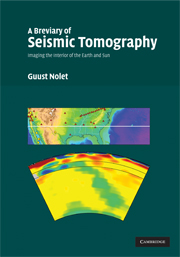Book contents
- Frontmatter
- Contents
- Preface
- 1 Introduction
- 2 Ray theory for seismic waves
- 3 Ray tracing
- 4 Wave scattering
- 5 Body wave amplitudes: theory
- 6 Travel times: observations
- 7 Travel times: interpretation
- 8 Body wave amplitudes: observation and interpretation
- 9 Normal modes
- 10 Surface wave interpretation: ray theory
- 11 Surface waves: finite-frequency theory
- 12 Model parametrization
- 13 Common corrections
- 14 Linear inversion
- 15 Resolution and error analysis
- 16 Anisotropy
- 17 Future directions
- References
- Author index
- General index
5 - Body wave amplitudes: theory
Published online by Cambridge University Press: 24 January 2011
- Frontmatter
- Contents
- Preface
- 1 Introduction
- 2 Ray theory for seismic waves
- 3 Ray tracing
- 4 Wave scattering
- 5 Body wave amplitudes: theory
- 6 Travel times: observations
- 7 Travel times: interpretation
- 8 Body wave amplitudes: observation and interpretation
- 9 Normal modes
- 10 Surface wave interpretation: ray theory
- 11 Surface waves: finite-frequency theory
- 12 Model parametrization
- 13 Common corrections
- 14 Linear inversion
- 15 Resolution and error analysis
- 16 Anisotropy
- 17 Future directions
- References
- Author index
- General index
Summary
As we have seen in Chapter 2, the energy density of a seismic wave decreases as the wave propagates because of geometrical spreading: the available energy spreads over a larger wavefront-surface, and therefore amplitudes should decrease to avoid an increase in the total energy of the system. Individual wave packets also lose energy because of scattering: part of the energy is redirected by refraction, or converted to a different kind of wave. Examples of this are P–S conversion at the Moho, or scattering at random heterogeneities.
In both cases, however, the total mechanical energy in the vibrating system (the Earth) remains the same. We know this cannot be true. At regular intervals, vibrational energy is added to the Earth, through release of potential energy (strain energy) in earthquakes, through the detonation of large explosions or simply when a train passes by. But even after a large earthquake, the activity on a short period seismograph returns to normal after a few hours. It may take days on a low frequency seismograph, but there, too, the energy eventually damps away. The mechanical energy of seismic waves is converted to other forms of energy, mostly heat. Such processes are inelastic, commonly referred to as ‘intrinsic attenuation’.
In this chapter we take a closer look at the factors that determine the amplitude of a body wave.
Geometrical spreading
In Section 2.7 we saw that the energy of a body wave in a spherically symmetric Earth is proportional to ∂2T/∂Δ2 = ∂p/∂Δ.
- Type
- Chapter
- Information
- A Breviary of Seismic TomographyImaging the Interior of the Earth and Sun, pp. 82 - 92Publisher: Cambridge University PressPrint publication year: 2008



